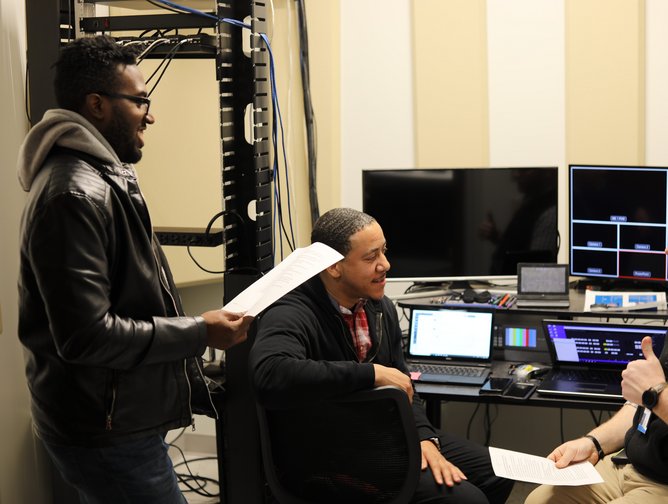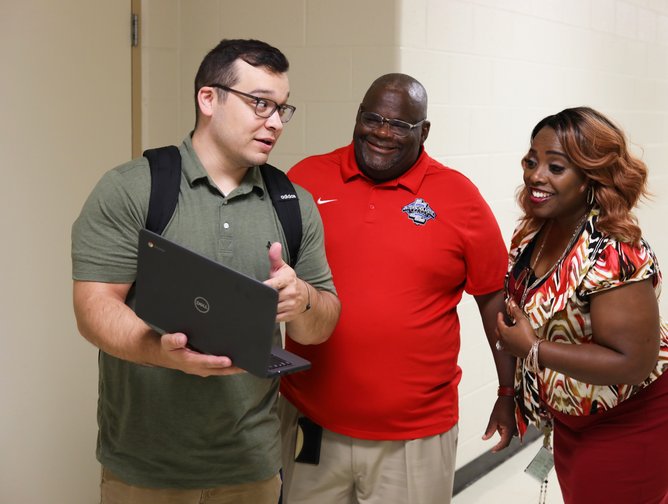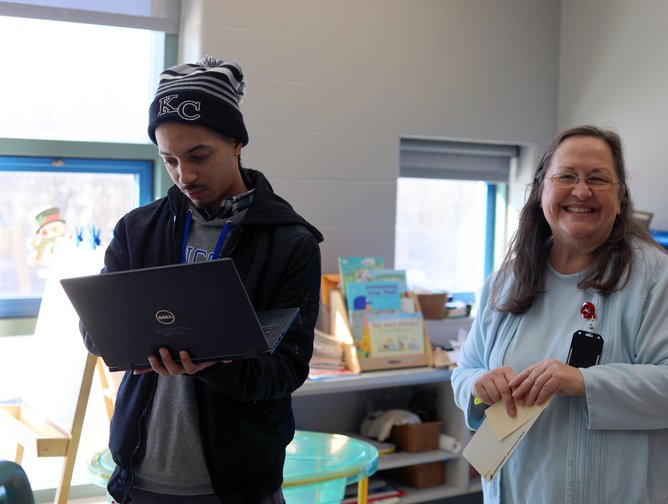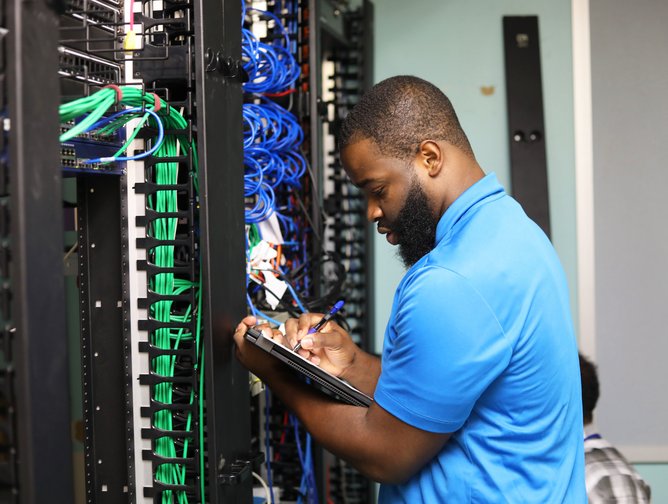Kansas City Public Schools: Creating The Classroom of Now
Digital transformation takes time and a considerable amount of resources, but for Kansas City Public Schools (KCPS), Joe Phillips, Director of Technology, asserts that his students cannot afford to wait. Few people understand the technological needs of the students more than Phillips, who grew up in Missouri, knowing first hand the disparity in educational support provided to children across the state.
Before he came to his current role, Phillips spent 16 years in the army as a Chief Human Resources Officer and Chief Information Officer. Following an injury in Afghanistan he was medically retired in 2015. “Leadership breaks down into three components: purpose, direction and motivation,” explains Phillips, “and my time in the army really prepared me for my current position at KCPS in providing direction and leadership to our team.”
Prior to his time at Kansas City Public Schools (KCPS), Phillips was the Manager of Technology Support Services at Park Hill School District, where he received the 2018 Spirit Award. Just recently he was nominated for the CoSN CTO of the year award for his work at KCPS. Yet Phillips is far more occupied with the achievements of the district. “My key responsibility in this role is to use technology to improve the lives of our students, and I am particularly invested as I know how our kids feel and what they face every day. They can’t wait several years for change, they need it now in order to be equipped for the future.”
The key way in which Phillips is doing this is via a project he calls ‘The Classroom of Now.’ “Many other districts may have projects called ‘The Classroom of Tomorrow’ or ‘The Classroom of the Future’, but our kids don’t have time to wait for this,” he says. Phillips shares that there are currently 42 technology projects underway to improve upon the district’s infrastructure, cybersecurity and classroom experience. “Our largest project is the district-wide refresh of technology, so that our students can get the best-of-the-best and our teachers aren’t hindered by technological difficulties.”
At the core of these edtech initiatives is a clear goal: to become the go-to strategic partner across the entire organisation. “If we can help every department improve upon their processes, procedures and technologies, then we can truly improve the experiences of our students.” This assistance may range from the effective technology training of teachers, through assisting in the selection and deployment of active shooter simulation technology for the security department. “All of this comes down to equity: identifying the challenges faced by our students in our district, and helping them to overcome these challenges so that they can have the same opportunities as higher-SES students when they go to college, or enter their career. We can’t simply keep pace with other school districts; we need to leapfrog our technologies so our students can remain competitive. Outdated technology won't equip our students for the future.”
KCPS is currently in the first year of a five year edtech plan which aligns with the district's strategic plan and goals. “Often, an issue that you see with regard to others in my position is that they decide on technology that they believe should be in place, they don’t necessarily work from the needs of the educators,” he explains, “This is where our team differs. We see what our educators would like to achieve in the next five years and we work backwards from there to provide the best processes and needs in order to become aligned.”
To really articulate the scope of this transformation, Phillips details the conditions of the classrooms when he first started in his role in 2019. “One of my first initiatives was to ensure the implementation of iReady, however the elementary schools in the district had exceptionally poor technology. The laptops couldn’t hold a charge and the students didn’t have power outlets at their desks,” he explains.
On Phillips’s 90th day as Director of Technology he approached his superintendent Dr. Mark Bedell and requested US$2mn. “Dr. Bedell and our board members are very supportive of the work we are doing and the project was easily approved.” After the first winter break, all students in grades three to six received new laptops, shortly followed with iPads for Kindergarten through to grade two. “This upgrade has made a huge difference on our ability to use technology to teach our kids as well as individualising our teaching for each student. We have also focused on reducing our average ticket time for IT problems and have been able to get it from 46 days down to under 48 hours.”
In addition to this, the vast number of projectors are being replaced with OneScreen interactive flat panels, which were provided by Clary Co, a company Phillips cites as pivotal in standardising teaching for staff across all schools in the district, which, when paired with strong training in technology, has positioned staff to be able to become more creative and attentive with their classes. “Technology anxiety has the power to undermine and destroy a whole transformation, so working with our Digital Learning Team and making sure our staff are trained and comfortable with these new technologies is paramount to our greater strategy,” he says. Phillips references Fred Davis’ 1989 Technology Acceptance Model, which was used as the framework for the staff training. He adds that for every rollout, a school in the district will pilot the technology, allowing for feedback and amendments prior to the district-wide rollout.
As technology evolves, naturally so does cybersecurity. “We have a layered approach to cybersecurity,” explains Phillips. “We have solid firewalls and end point detection and response software. We’re also following all NIST cybersecurity standards, CIS controls, CIPA, HIPPA, and FERPA where we modify it by grade range and the topics studied by students as needed.” KCPS also adheres closely to the Children’s Online Privacy Protection Act (COPPA), which ensures stricter security levels for children under the age of 13. “It is so crucial that educators understand cybersecurity and the threat it poses,” he says. To illustrate the gravity of the situation, Phillips shares that on the dark web, a student’s information is worth around $30 a transaction, as opposed to that of an adult, whose data is worth around 30 cents. “It’s important to understand that simple solutions can have a massive impact.” He goes on to share that KCPS has an email address for students and educators to forward suspect emails onto, as well as a warning banner that heads suspect emails external to the district. “From these solutions alone we have seen a massive decrease in phishing attempts across the district,” he remarks. A partner that has been integral to cybersecurity is Lightspeed Systems, which has assisted in a number of ways: piloting classroom management, staff monitoring and controlling what students see as well as the projection of work. Lastly, it provides a safety check that centers around self-harm, bullying and anything else that may place students at risk.
KCPS has already made great strides in the first year of this transformation and Phillips takes pride in this. “My favorite part of this transformation is seeing the impact. I grew up in this district and I remember how easy it is to succumb to feelings of inferiority when relating to suburban districts.”
“Seeing our students, who have been using these depleted laptops, unbox a new chromebook halfway through the academic year was absolutely incredible. They’re durable and cutting edge and the students' reactions were amazing; they realise that their education is valuable, and that they are valuable. Yet in my role, I need to ensure that the best-of-the-best technologies feel normal for our students and that they never feel that their education isn’t as valuable as their suburban counterparts.”
Looking ahead, Phillips makes his intentions clear: “It’s no secret that I want us to be the best K-12 technology department in the world. I want KCPS to be the first thing that people associate with K-12 EdTech, and not for personal ego, but because our students truly deserve the best.”
Phillips also wants to harness VR in the classrooms, to take students on virtual field trips. He is also interested to see how the role of 3D printing will evolve. “3D printing has been something of a novelty, but I believe it has the potential to serve a greater purpose in helping students learn.” When considering his position in the wider industry, Phillips comments, “CTOs need to move from the basement to the boardroom: we need to be out across the schools and departments building strategic partnerships and really trying to understand what our schools and departments need from us.” Phillips says that KCPS is in an excellent position to accelerate to transform from what he describes as “the underdog of school districts” to a Missouri leader, in time a regional leader, and eventually a global leader.






- Top 100 Women 2024: Tanja Rueckert, Bosch - No. 6Digital Transformation
- Coforge: Arming Financial Firms with the Tools to InnovateDigital Transformation
- Coforge: Arming Financial Firms with the Tools to InnovateDigital Transformation
- MWC24: Harnessing AI to Modernise Telcos with Tech MahindraDigital Transformation

